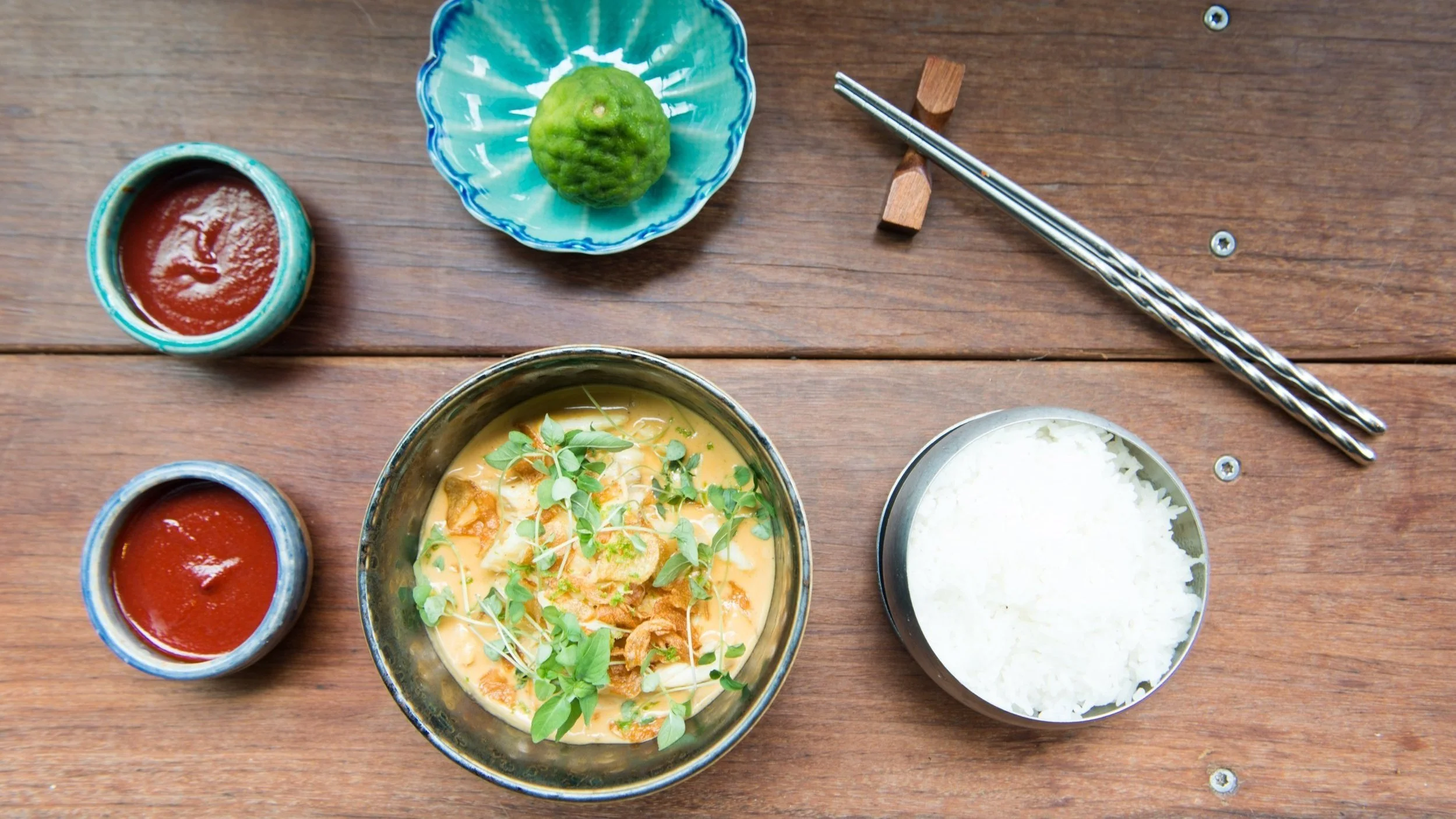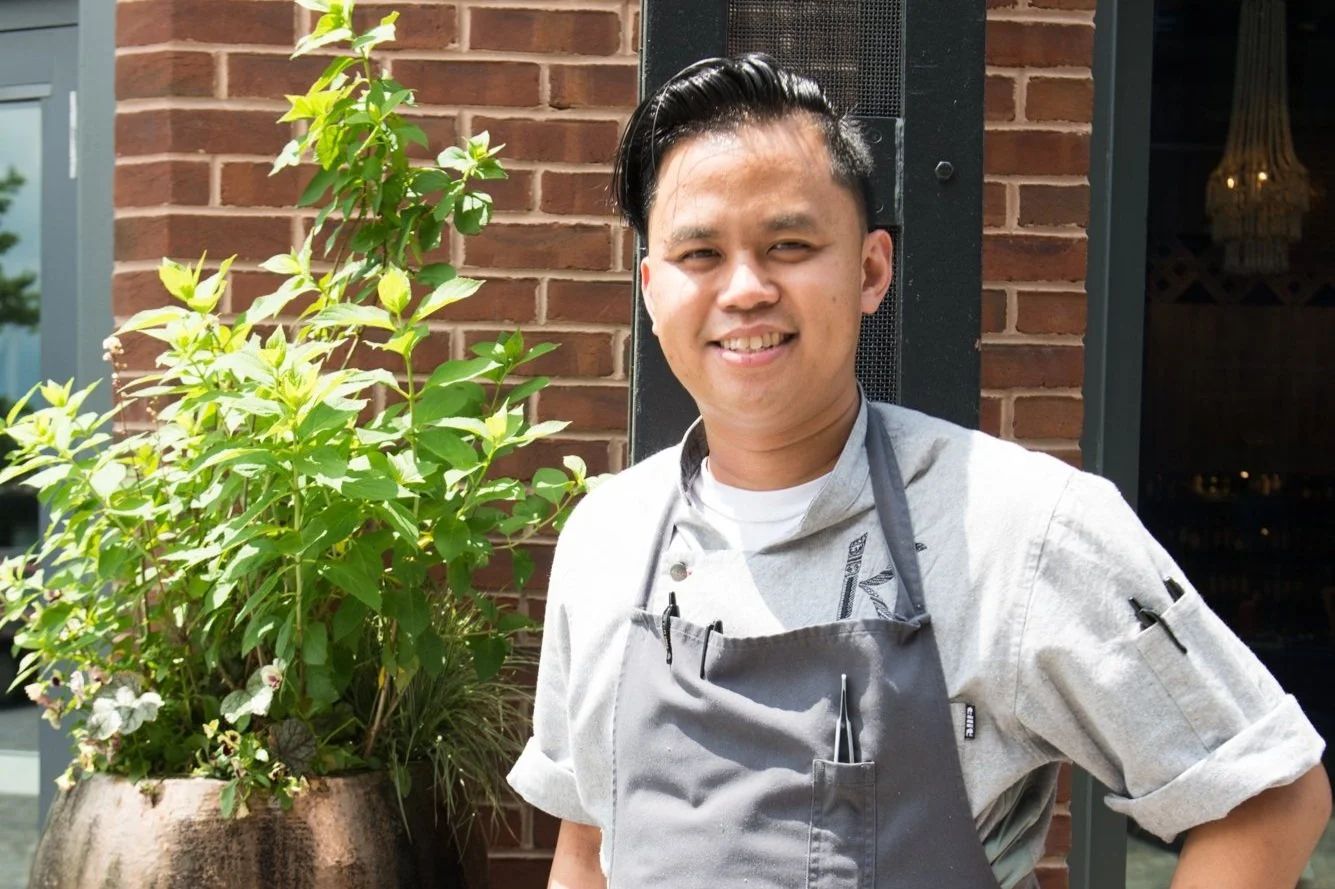Move Over, Mambo
The Capital has all the house sauces—from gochujang and banana ketchup to fish sauce and chile crisp.
Banana ketchup, gochujang, and crab curry at Kaliwa | Photos: Alexa Bendek
Ready to move on from Mambo? The Chinese take-out staple may be a D.C. signature, but area chefs are making condiments that rival that stalwart, and are paying homage to more traditional Asian cuisines. They’re ditching commercial staples—things like fish sauce and gochujang—in favor of house-made versions.
At Kaliwa, Chef de Cuisine Paolo Dungca makes gochujang (get the recipe here) by cooking glutinous rice flour, fermented soybean powder, and the liquid from soaking malted barley in a low oven—set at 60°C—for five hours. When reduced and cooled, Dungca tosses in gochugaru, sea salt, and brown rice syrup. He packs the mixture into traditional earthenware jars that are stashed near the restaurant entrance—which is practical (since it’s the right temperature) and sets killer vibes. Covered with cheesecloth, the gochujang ferments for one to two weeks. “Once it starts to develop mold, we scrape off the top and put it in the walk-in to [allow for] a slow fermentation,” says Dungca. The key is adhering to his HACCP plan. “Gochujang is time sensitive. It’s all about following the procedure.”
His banana ketchup requires less babysitting. The Filipino sauce is a mix of onions sweated with garlic, ginger, and jalapeño. He adds ground turmeric, allspice, and tomato paste; deglazes with white wine vinegar; adds palm sugar, soy sauce, and mashed ripe bananas; and simmers the mixture until thick and glossy. He says the taste is closer to barbecue sauce than classic banana ketchup brands like Jufran, but he does finish it with a touch of red food coloring to give it a familiar look.
Dungca’s team uses the banana ketchup to glaze grilled pork belly and as a dipping sauce. The gochujang is their staple chile paste—it goes into marinades and rubs—but it’s also the star of their bibimbap and sets off raw tuna hoe-deopbap with its earthy, bright, vibrant flavor.
Inasal Na Manok: Wood-Grilled Chicken, Lemongrass, Annatto, Atchara, Serrano Pepper
Chef de Cuisine Paolo Dungca of Kaliwa
Up the road at Thip Khao, Chefs Seng Luangrath and Bobby Pradachith are making padaek, a Laotian fish sauce. “It is essential to Lao cooking,” says Pradachith, “and very distinct from other fish sauces.” Unfiltered, padaek isn’t the amber-hued liquid funk you might be used to. Instead, it’s a “slightly chunky, grey sauce” made from whole fish (“any kind, but nothing too fatty”) that’s been cut into large pieces and salted overnight. Pradachith includes skin and bone in his version, and says that “if you want it to develop some bitterness, you can leave in the innards.” He toasts rice until the kernels are browned through to the center—some charring is okay. Ground to a coarse powder, the rice is tossed with the salted fish and forms a paste with the liquid that’s been drawn out from curing. The mixture ferments away from sunlight and covered with cheesecloth for at least a year.
“If you start using padaek too soon, the flavor will be overbearing,” says Pradachith. All salt, no substance. “The more you let it ferment, the salt will subdue and you’ll get this tinge of sweetness on the back of the tongue.”
They simmer the fully fermented sauce to pasteurize, but not reduce it. To finish, it’s puréed and bottled. Because it’s unfiltered, “the flavor will continue to develop,” as sediment collects at the bottom of the holding vessel. To use the sauce, Pradachith might stir the sediment in or strain it out, but he never throws the sediment away. “It’s very versatile. It can be used in a marinade or a sauce.”
Seng Luangrath and Bobby Pradachith of THip Khao
Tam Muk Houng: Green Papaya, Padaek, Fermented Shellfish, Chile, Tomato, Eggplant, Lime, Garlic, Puffed Rice
At Fry’s Spring Station in Charlottesville, Virginia, Chef Tommy Lasley’s “Angry Grandma Sauce” may be Asian-inspired, but he’s putting it to use in every way but. Based on Szechuan-style chile crisp, Lasley named his sauce after the “less-than-happy” brand ambassador pictured on jars of Lao Gan Ma. When he realized how much of that Move Over, Mambo House gochujang at Kaliwa condiment his kitchen was going through, he started making his own by infusing oil with Szechuan peppercorns; ancho, chipotle, and japones chiles; black pepper, and crushed red pepper. He mixes that oil 50/50 with sesame oil and heats the mix to 400°F.
Separately, he fries sliced shallots, garlic, dry-roasted soybeans, peanuts, and a brunoise of extra-firm tofu. All those crunchy components are tossed together and the hot oil is poured over the top. The ingredients sizzle violently “as the flavors fuse together.” Just as the other house sauces, “the longer it sits, the better it gets.”
Lasley uses the spicy, numbing oil in a variety of ways, but menu staples include fried chicken wings tossed in the sauce with scallion and cilantro, then topped with daikon pickles. He does a similar preparation with cheese curds for a vegetarian alternative. Lasley also mixes it into a white sauce for pizza and blends it into an aïoli that he spreads on a smoked pork sandwich with nước chấm slaw. And if chile crisp aïoli doesn’t make you want to toss that Mambo sauce out the window, nothing will.
Narragansett-Battered Wisconsin Cheddar Curd, Szechuan Peppercorn Oil, Pickled Daikon, Cilantro, And House Ranch
Chef Tommy Lasley of Fry’s Spring Station













